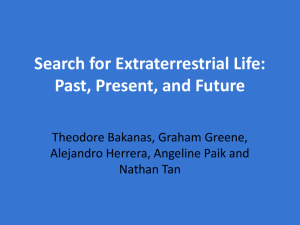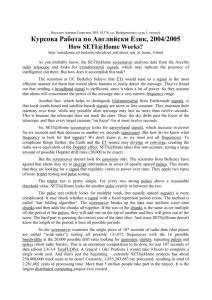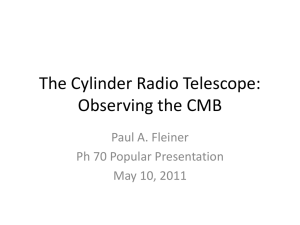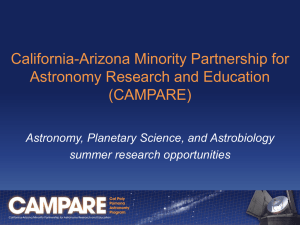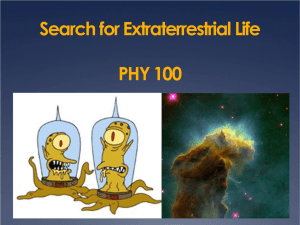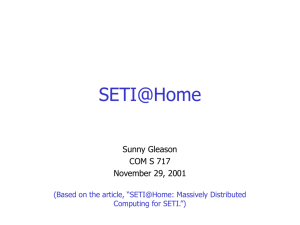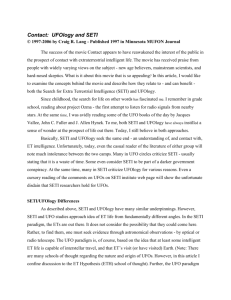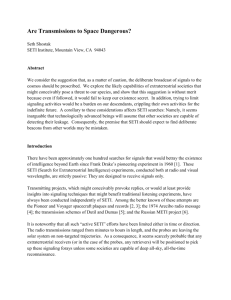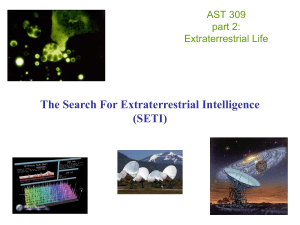Team #6 Presentation - Department of Earth and Planetary Sciences
advertisement
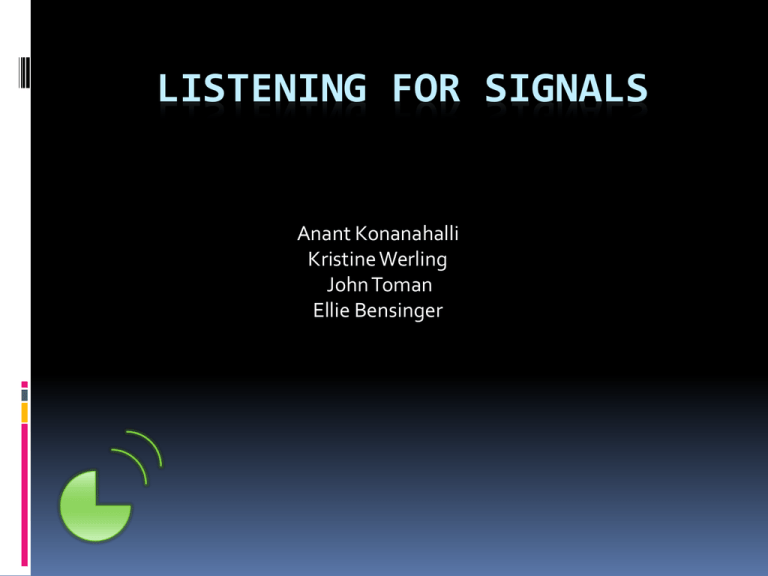
LISTENING FOR SIGNALS Anant Konanahalli Kristine Werling John Toman Ellie Bensinger Mission Def-D-6 “Define Drake’s 6th Variable” Fc = fraction of civilizations that develop a technology that releases detectable signs of their existence into space. Why listen for signals? • The ability of an extraterrestrial civilization to send a signal would indicate their presence and intelligence. Def-D-6 What are we looking for? “Radio signals coming from outer space that have no causal factors” –SETI “Narrow-bandwidth radio signals: --SETI Not known to occur naturally Indicate artificial source = Extraterrestrial Life Def-D-6 Def-D-6 Plan Proposal Focus Projects 1) Allen Array Telescope 2) Big Ear 3) SETI@home Projects to Cut 1) CETI Def-D-6 Allen Telescope Array: What is it? ‘One Hectare Telescope’ 2007 at Hat Creek Observatory, Cascade Mountains SETI Institute + Radio Astronomy Laboratory Def-D-6 Allen Telescope Array: What does it do? Purpose Two-Fold Conventional radio astronomy projects SETI SETI Focus 1) Sky sweep survey 2) Targeted Searches Data collected 4.5 octaves of frequency Def-D-6 Def-D-6 Allen Telescope Array: How does it do it? LNSD array = Large Number of Small Dishes 42 dishes Pseudo-random arrangement 1 km circle Def-D-6 Allen Telescope Array: How does it do it? • Basic Signal Collection Radio waves collected at antenna Radio waves focused Converted to electrical signals Amplified Processed Beam Width Limitation: Sinθ= 1.22λ/D Def-D-6 Allen Telescope Array: How does it do it? • Array Advantage Combined to form equivalent of single large dish Beam Width Limitation: D Sinθ= 1.22λ/ Def-D-6 Allen Telescope Array: How does it do it? Adjustments to ‘listen’ in different directions Alter cable lengths and electronic delays Bring waves from different direction in-phase Def-D-6 Allen Telescope Array: How does it do it? Offset Optic or Gregarian Antenna System “Because sometimes, as in football, going to the side can reduce interference” Def-D-6 Allen Telescope Array: Why Invest? Array vs Single Large Disk Lower cost Easier adjustments/repairs Easy to add on/improve Multipurposed Radio astronomy SETI Speed up SETI searches 24hr data collection Simultaneity Larger sky area Def-D-6 Allen Telescope Array: Modifications Expand to the “Square Kilometer Array” Expand to 350 dishes Angular resolution of 700 meter diameter dish Comparable to Robert C. Byrd Telescope and Very Large Array Def-D-6 Ohio State University Radio Observatory (Big Ear) John D. Kraus, built/design Small Ear Prototype NSF grant to start Big Ear Considerably less than req’d Had to scale down 2000 ft.360 ft. in length Main Components 1. 2. 3. Flat Reflector Paraboloidal Reflector Feed Horns Def-D-6 Big Ear: Flat Reflector 340 ft. x 100 ft. Wire Mesh Ability to tilt Unfocused waves Ground Plane Def-D-6 Big Ear: Paraboloidal Reflector 360 ft. x 170 ft. Focused the sent waves Wavelengths ~21.1 cm (8.3 inches) 1411-1420 MHz Def-D-6 Big Ear: Feed Horns Two Horns Funneled waves Signal Switch (79x) Why Switch? See the same area twice in 2.5-5 minutes 2. Removed variation due to drift and sky variation 1. Def-D-6 Big Ear: Recap Big Ear: WOW! Signal Jerry R. Ehman 1977 Coded Intensity Found at 1420 MHz Sagittarius Lasted 72 seconds, not replicated Even Very Large Array could not detect Earth-borne signal reflected off space debris 2. One-time burst 1. Def-D-6 Big Ear: Justifications for Use Started from NSF grant of $48,000 $450,000 today with inflation Need to resolve this signal via further investigation Physically impossible for WOW! to bounce off of debris, 1420 MHz is restricted, something is up. Very Large Array ($78.5M) is very similar and has made key observations of black holes and protoplanetary disks. Def-D-6 SETI@home: Overview • Released to the public in May of 1999 • Over 5 million users worldwide • Has completed 2 million hours of computing time Primary Goals 1) to do useful scientific work by supporting an observational analysis to detect intelligent life outside Earth 2) to prove the viability and practicality of the 'volunteer computing' concept. Def-D-6 SETI@home: How it Works Searches for possible radio transmissions from ETs Uses observational data from Arecibo Data digitized and sent to SETI@home Def-D-6 SETI@home: How it Works Parses data into millions of very small chunks Anyone can download software onto their computer Personal computers use processing power to analyze these chunks (variations) Def-D-6 SETI@home: Justifications SETI@home doesn’t use government funding Berkeley has found ways to work with small budgets and donations Increasing power of home computers/laptops Other applications of interest Def-D-6 SETI@home: Possible Modifications Alternative to Arecibo telescope Better hardware quality Increased marketing efforts Def-D-6 CETI Communication with Extraterrestrial Intelligence Subset of SETI Researching effective means of communication Def-D-6 Previous CETI projects Arecibo Message (1974): Radio message to starcluster M13 Binary- DNA, Map of Solar System Cosmic Calls 1 and 2 (1999) Sent to several stars Contained text, audio, video, “Rosetta Stone” version of Arecibo Doritos Commercial (2008) Def-D-6 CETI entails… Hiring social scientists: Douglas Vachok Creating mathematical and scientific languages Creating pictorial languages Lincos: Lingua cosmica Figuring out best representation Binary, Radio, Pulse Def-D-6 Noble but not necessary yet… Already so much data to decode “Linear A” problem Un-decoded early human language SETI- Interstellar Message Composition Closest Earth like planet: Gliese 581 system 20 light years away 40 year exchange Def-D-6 First Things First Fund programs that are looking for incoming data Most likely way of detecting life Once we find something, then maybe CETI Def-D-6 References Douglas A. Vakoch. "To the Stars, Silently." Leonardo 37.4 (2004): 265-265. Project MUSE. Web. 7 May. 2013. <http://muse.jhu.edu/>. Douglas A. Vakoch. "The Art and Science of Interstellar Message Composition." Leonardo 37.1 (2004): 32-34. Project MUSE. Web. 7 May. 2013. <http://muse.jhu.edu/>. Freudenthal, Hans. Lincos; Design of a Language for Cosmic Intercourse. Amsterdam: North-Holland Pub., 1960. "SETI Institute." SETI Institute. N.p., n.d. Web. 07 May 2013. http://www.redorbit.com/media/uploads/2004/10/6_3e3fcbe6f4bfa435cdb6eeb6ff721f3c2.jpg http://www.setileague.org/photos/miscpix/drakeqn.jpg http://www.scienceprog.com/wp-content/uploads/2008i/DSP1/Radar_location_and_DSP.gif http://voices.yahoo.com/seti-detects-alien-signal-outer-space-we-are-2745373.html http://setiathome.berkeley.edu/sah_about.php http://openseti.org/OSSearch.html Def-D-6
